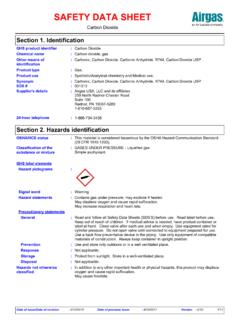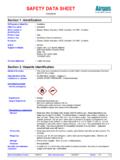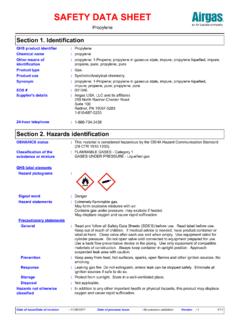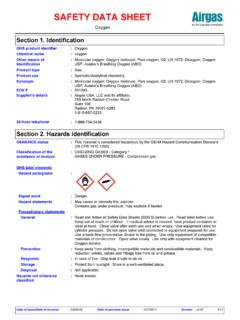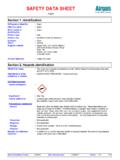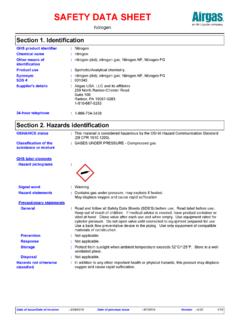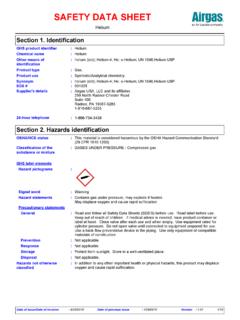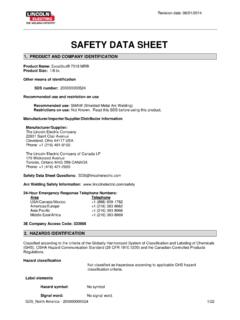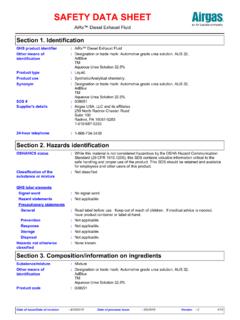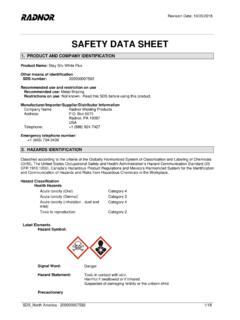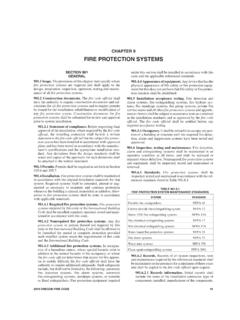Transcription of SAFETY DATA SHEET - Airgas
1 carbon MonoxideMonoxide; Flue gas; carbon oxide; carbonic oxide; Monoxide of carbon ; carbon DATA SHEETGHS product identifierOther means of identificationProduct typeSection 1. Identification:::Chemical name: carbon monoxideSupplier's details: carbon MonoxideProduct use:Synthetic/Analytical :Monoxide; Flue gas; carbon oxide; carbonic oxide; Monoxide of carbon ; carbon monooxideSDS #:001014 Airgas USA, LLC and its affiliates259 North Radnor-Chester RoadSuite 100 Radnor, PA 19087-52831-610-687-52531-866-734-3438:2 4-hour telephoneSection 2. Hazards identificationFLAMMABLE GASES - Category 1 GASES UNDER pressure - Compressed gasACUTE TOXICITY (inhalation) - Category 3 TOXIC TO REPRODUCTION - Category 1 SPECIFIC TARGET ORGAN TOXICITY (REPEATED EXPOSURE) - Category 1 Classification of the substance or mixture:Signal word:DangerHazard statements:Extremely flammable gas under pressure ; may explode if if damage fertility or the unborn damage to organs through prolonged or repeated pictograms:Precautionary statementsPrevention:Obtain special instructions before use.
2 Wear protective gloves. Wear protective clothing. Wear eye or face protection. Keep away from heat, hot surfaces, sparks, open flames and other ignition sources. No smoking. Use only outdoors or in a well-ventilated area. Do not breathe gas. Do not eat, drink or smoke when using this label elementsGeneral:OSHA/HCS status:This material is considered hazardous by the OSHA Hazard Communication Standard (29 CFR ).Asphyxiating even with adequate form explosive mixtures with and follow all SAFETY Data Sheets (SDS S) before use. Read label before out of reach of children. If medical advice is needed, have product container or label at hand. Close valve after each use and when empty.
3 Use equipment rated for cylinder pressure . Do not open valve until connected to equipment prepared for a back flow preventative device in the piping. Use only equipment of compatible materials of construction. Approach suspected leak area with of issue/Date of revision:11/5/2020 Date of previous issue:7/29/2020 MonoxideSection 2. Hazards identificationResponse:Leaking gas fire : Do not extinguish, unless leak can be stopped safely. In case of leakage, eliminate all ignition sources. IF exposed or concerned: Get medical advice or attention. IF INHALED: Remove person to fresh air and keep comfortable for a POISON CENTER or :Store locked up. Protect from sunlight.
4 Store in a well-ventilated :Dispose of contents and container in accordance with all local, regional, national and international not otherwise classified:None 3. Composition/information on ingredientscarbon monoxide100630-08-0 Ingredient nameCAS number%There are no additional ingredients present which, within the current knowledge of the supplier and in the concentrations applicable, are classified as hazardous to health or the environment and hence require reporting in this name: carbon monoxideOther means of identification:Monoxide; Flue gas; carbon oxide; carbonic oxide; Monoxide of carbon ; carbon monooxideCAS number:630-08-0 Substance/mixtureCAS number/other identifiers:Occupational exposure limits, if available, are listed in Section concentration shown as a range is to protect confidentiality or is due to batch code:001014As this product is a gas, refer to the inhalation flush eyes with plenty of water, occasionally lifting the upper and lower eyelids.
5 Check for and remove any contact lenses. Continue to rinse for at least 10 minutes. Get medical contaminated skin with plenty of water. Remove contaminated clothing and shoes. To avoid the risk of static discharges and gas ignition, soak contaminated clothing thoroughly with water before removing it. Continue to rinse for at least 10 minutes. Get medical attention. Wash clothing before reuse. Clean shoes thoroughly before victim to fresh air and keep at rest in a position comfortable for breathing. If it is suspected that fumes are still present, the rescuer should wear an appropriate mask or self-contained breathing apparatus. If not breathing, if breathing is irregular or if respiratory arrest occurs, provide artificial respiration or oxygen by trained personnel.
6 It may be dangerous to the person providing aid to give mouth-to-mouth medical attention. If necessary, call a poison center or physician. If unconscious,place in recovery position and get medical attention immediately. Maintain an open airway. Loosen tight clothing such as a collar, tie, belt or 4. First aid measuresEye contactSkin contactInhalationIngestion::::Descriptio n of necessary first aid measuresMost important symptoms/effects, acute and delayedInhalation:Toxic if contact:Contact with rapidly expanding gas may cause burns or with rapidly expanding gas may cause burns or frostbite.:Eye contactPotential acute health effectsFrostbite:Try to warm up the frozen tissues and seek medical of issue/Date of revision:11/5/2020 Date of previous issue:7/29/2020 MonoxideSection 4.
7 First aid measuresProtection of first-aiders:No action shall be taken involving any personal risk or without suitable training. If it is suspected that fumes are still present, the rescuer should wear an appropriate mask or self-contained breathing apparatus. It may be dangerous to the person providing aid to give mouth-to-mouth resuscitation. Wash contaminated clothing thoroughly with water before removing it, or wear to physician:Treat symptomatically. Contact poison treatment specialist immediately if large quantities have been ingested or treatments:No specific this product is a gas, refer to the inhalation section.:IngestionOver-exposure signs/symptomsSkin contactIngestionInhalationAdverse symptoms may include the following:, reduced fetal weight, increase in fetal deaths, skeletal malformationsAdverse symptoms may include the following:, reduced fetal weight, increase in fetal deaths, skeletal malformationsAdverse symptoms may include the following:, reduced fetal weight, increase in fetal deaths, skeletal malformations:::Eye contact:No specific toxicological information (Section 11)Indication of immediate medical attention and special treatment needed, if necessarySection 5.
8 fire -fighting measuresPromptly isolate the scene by removing all persons from the vicinity of the incident if there is a fire . No action shall be taken involving any personal risk or without suitable training. Contact supplier immediately for specialist advice. Move containers from fire area if this can be done without risk. Use water spray to keep fire -exposed containers cool. If involved in fire , shut off flow immediately if it can be done without risk. If this is impossible, withdraw from area and allow fire to burn. Fight fire from protected location or maximum possible distance. Eliminate all ignition sources if safe to do thermal decomposition productsSpecific hazards arising from the chemicalDecomposition products may include the following materials: carbon dioxidecarbon monoxideContains gas under pressure .
9 Extremely flammable gas. In a fire or if heated, a pressure increase will occur and the container may burst, with the risk of a subsequent should wear appropriate protective equipment and self-contained breathing apparatus (SCBA) with a full face-piece operated in positive pressure protective equipment for fire -fightersUse an extinguishing agent suitable for the surrounding media:::None extinguishing media:Unsuitable extinguishing media:Special protective actions for fire -fighters:Section 6. Accidental release measuresPersonal precautions, protective equipment and emergency procedures:Accidental releases pose a serious fire or explosion hazard. No action shall be taken involving any personal risk or without suitable training.
10 Evacuate surrounding unnecessary and unprotected personnel from entering. Shut off all ignition sources. No flares, smoking or flames in hazard area. Do not breathe gas. Provide adequate ventilation. Wear appropriate respirator when ventilation is inadequate. Put on appropriate personal protective non-emergency personnelDate of issue/Date of revision:11/5/2020 Date of previous issue:7/29/2020 MonoxideSection 6. Accidental release measuresEnvironmental precautionsImmediately contact emergency personnel. Stop leak if without risk. Use spark-proof tools and explosion-proof equipment. Note: see Section 1 for emergency contact information and Section 13 for waste disposal.
